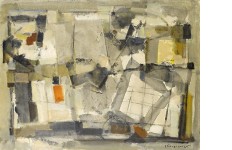TITΛΟΣ ΕΡΓΟΥΗ ΑΘΗΝΑ ΑΠΟ ΤΗΝ ΑΚΡΟΠΟΛΗ
ΔΙΑΣΤΑΣΕΙΣ ΕΡΓΟΥΎψος : 60.5
Πλάτος : 80.5
ΥΛΙΚΟ ΚΑΤΑΣΚΕΥΗΣΕλαιογραφία (Λάδι σε καμβά)
ΥΠΟΓΡΑΦΗ ΚΑΛΛΙΤΕΧΝΗΚάτω Δεξιά
ΧΡΟΝΟΛΟΓΗΣΗ
ΕΛΕΓΧΟΣ ΓΝΗΣΙΟΤΗΤΑΣΔεν έχει ελεγχθεί

Footnotes
Acquired directly from the artist in 1951 by the present owner.
A powerful mixture of simplicity and sophistication and a wise conciliation between gestural brushwork and sturdy compositional structure, this captivating work strikes a perfect balance between reason and emotion, logos and pathos. From the artists output of the late 1950s and most probably from his renowned Anafiotika (the quaint Athenian neighbourhood perched on the foot of the Acropolis) series, it offers a commanding display of technical discipline and intuitive expression. The shapes are complex and they interlock with great strength, but they express tenderness as well as power, peace as well as tension, discipline as well as unleashed feeling.1
Planes, surfaces and textures are meticulously analysed by dark structural outlines, while intense counterbalancing forces and energetic shapes are articulated into a serene and robust geometrical structure set in motion by circular gestural marks that endow the composition with an improvised yet coherent inner rhythm.2 The Greek scenery with its architecture of masonry fences, arches, courtyards and dry stone walls, observed from afar as outlined geometrical shapes, constituted the onset of visual stimulation before becoming a painterly proposal. Imposing volumes in the glaring sun that stirred the artists imagination with their juxtaposed dark and bright surfaces.3
This beautiful canvas, invested with a sense of colour that is rich and yet subdued, also reflects Spyropoulos deep interest in Byzantine art. Professor C. Christou notes: The golden-yellow colour that comes to dominate the work of Spyropoulos by 1960 and which in essence reflects nothing more than the presence of sunlight, or rather Greek light, is something he finds around and within himself, in the past from which he hails and the present where he belongs. It reveals the influence of the Byzantine icon painting he grew up with and his familiarity with the Greek light under which he lives, while at the same time his work expresses the intricate nature of modern artistic creation.4
Yiannis Spyropoulos was the first Greek painter who, while residing permanently in Greece, managed to attain an illustrious international career, highlighted by his participation in the 1960 Venice Biennale, where he was awarded the UNESCO prize. His works, which represent the most advanced and mature aspect of Greek abstraction, have been included in prestigious private collections around the globe -particularly in America where this painting comes from- and exhibited at the most important European and American museums of modern art.5
1. See A. Weller, C. Spencer, J.P. Hodin, The Art of Jannis Spyropoulos adapted by B. Rothberg, The Charioteer review, no. 10, 1968, pp. 66-69.
2. See E. Ferentinou, Jannis Spyropoulos [in Greek], Zygos magazine, no.32, July 1958, p. 18.
3. L. Tsikouta, Processes, Influences, Assimilations, Personal Idiom, Birth of an Artwork: The Case of Jannis Spyropoulos in Jannis Spyropoulos, The Classicist of Abstraction, exhibition catalogue, National Gallery-Alexandros Soutzos Museum, Athens 1995, p. 141.
4. C.Christou, Jannis Spyropoulos [in Greek], Athens 1962, p. 158
5. See H. Kambouridis - G. Levounis, Modern Greek Art, The 20th Century, Athens 1999, pp. 156-158.